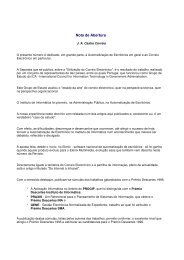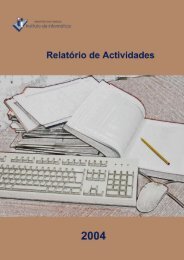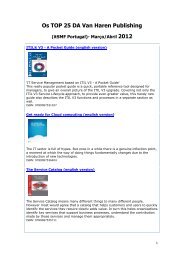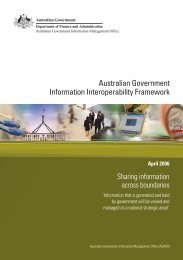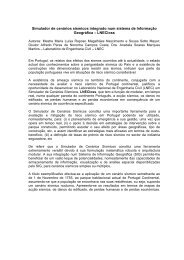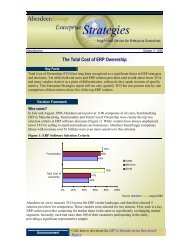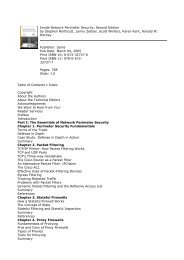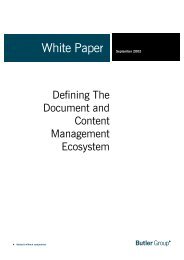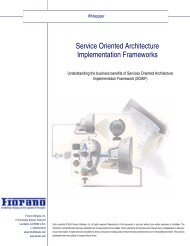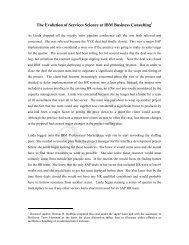OECD Peer Review of E-Government in Denmark - ePractice.eu
OECD Peer Review of E-Government in Denmark - ePractice.eu
OECD Peer Review of E-Government in Denmark - ePractice.eu
Create successful ePaper yourself
Turn your PDF publications into a flip-book with our unique Google optimized e-Paper software.
pharmacies (e.g. referrals and discharge letters, laboratory results, X-ray letters, prescriptions and<br />
hospital bill<strong>in</strong>g, etc.) This first project (MedCom I) ran from 1994 to 1996.<br />
Slow dissem<strong>in</strong>ation and adoption <strong>of</strong> MedCom I standards led to a second project (MedCom II),<br />
undertaken dur<strong>in</strong>g 1997-1999. The primary purpose <strong>of</strong> MedCom II was to ensure rapid and<br />
widespread adoption <strong>of</strong> MedCom I standards. In addition, the scope <strong>of</strong> the project was broadened to<br />
<strong>in</strong>clude local authorities, physiotherapists, dentists and telemedic<strong>in</strong>e <strong>in</strong>itiatives. Internet technology<br />
was also start<strong>in</strong>g to be used widely <strong>in</strong> Danish government, and so was <strong>in</strong>corporated <strong>in</strong>to the design <strong>of</strong><br />
the MedCom standards. MedCom II resulted <strong>in</strong> EDI-based communication <strong>in</strong> the health sector<br />
between hospitals, medical practices, and pharmacies becom<strong>in</strong>g more common, with around 1.3<br />
million “messages” exchanged each month (represent<strong>in</strong>g 30-50% <strong>of</strong> the total number <strong>of</strong> messages<br />
exchanged <strong>in</strong> the sector at that time). By the end <strong>of</strong> 1999, more than 2000 medical practices,<br />
pharmacies, hospitals, and laboratories were connected to the MedCom healthcare data network.<br />
In a 1999 f<strong>in</strong>ancial agreement between counties and the State government, MedCom was made a<br />
permanent fixture, with the goal that it would contribute to the development, test<strong>in</strong>g, dissem<strong>in</strong>ation<br />
and quality assurance <strong>of</strong> electronic communications <strong>in</strong> support <strong>of</strong> good patient progression thorough<br />
the health system. It became clear that large-scale usage <strong>of</strong> EDI was creat<strong>in</strong>g quality assurance<br />
problems, ma<strong>in</strong>ly due to EDI service providers implement<strong>in</strong>g the MedCom standards differently. This<br />
led to establishment <strong>of</strong> the MedCom III project, which focused on this issue, dur<strong>in</strong>g 2000/01.<br />
S<strong>in</strong>ce 2002, work has been ongo<strong>in</strong>g on MedCom IV which, to a large extent, builds upon<br />
MedCom III. MedCom IV consists <strong>of</strong> four sub-projects:<br />
3. An Internet strategy aimed at fully develop<strong>in</strong>g the national, Internet-based health care data<br />
network.<br />
4. Municipal projects aimed at achiev<strong>in</strong>g large-scale use <strong>of</strong> MedCom standards for<br />
communication between hospitals and municipal health services.<br />
5. The XML-EHR communication project, aimed at achiev<strong>in</strong>g nation-wide use <strong>of</strong> all relevant<br />
MedCom standards for communication with<strong>in</strong> and between hospitals.<br />
6. The SUP project aims at achiev<strong>in</strong>g Internet access to EHRs, both with<strong>in</strong> a county and across<br />
county boundaries.<br />
Today, standards-based EDI has overtaken paper-based communication <strong>in</strong> the Danish health<br />
sector. EDI is used by 88% <strong>of</strong> general practitioners, 57% <strong>of</strong> specialists, 100% <strong>of</strong> pharmacies and<br />
hospitals and 26% <strong>of</strong> local authorities. Examples <strong>of</strong> the benefits <strong>in</strong>clude time sav<strong>in</strong>gs <strong>of</strong> around 50<br />
m<strong>in</strong>utes per day for medical practitioners, and a 66% reduction <strong>in</strong> follow-up telephone calls for<br />
hospitals.<br />
One <strong>of</strong> the most significant and public outcomes <strong>of</strong> MedCom so far has been the development <strong>of</strong><br />
<strong>Denmark</strong>’s health sector portal, www.sundhed.dk (Health <strong>Denmark</strong>), based on MedCom standards.<br />
The portal is the ma<strong>in</strong> Internet access po<strong>in</strong>t to Danish health authorities, facilitat<strong>in</strong>g communication<br />
and services between health pr<strong>of</strong>essionals and citizens and allow<strong>in</strong>g users to book appo<strong>in</strong>tments with<br />
GPs, receive e-mail consultations, and renew prescriptions.<br />
152



